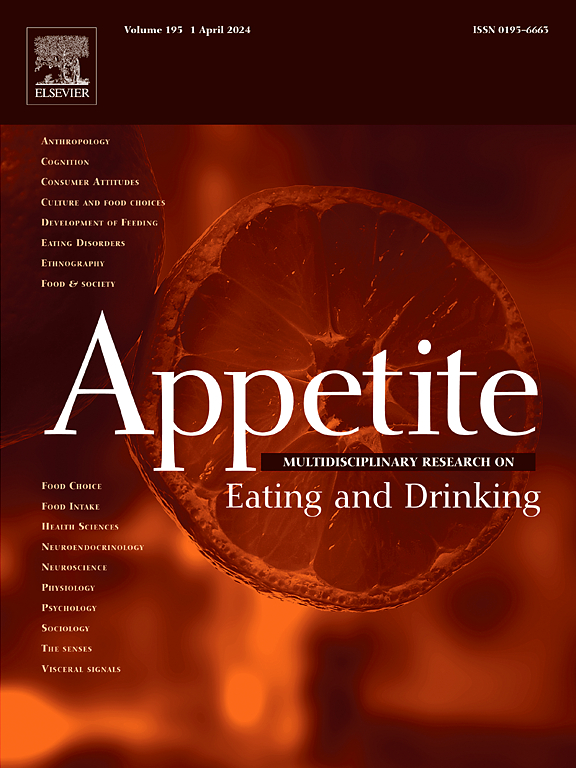“及时”但有点延迟:个性化的数字推动健康的在线食品选择。
IF 4.6
2区 医学
Q1 BEHAVIORAL SCIENCES
引用次数: 0
摘要
随着人们越来越多地在网上超市等环境中选择食物,“助推”已经被推断到数字领域。数字化为加强在线推广更健康的食品选择提供了独特的机会:根据最初选择的不健康产品,可以“及时”提供数字推送。此外,数字JIT推动可以个性化,以匹配行为相关的用户特征,例如一个人的食物和认知加工偏好。我们研究了通过用户匹配的数字即时推送的个性化内容(即强调健康与价格)和/或类型(即基于文本的推送与基于图像的推送)是否会提高推送效果和更健康的食品购买,并评估了这些增强效果潜在的心理机制。在一项2(推动内容:非个性化vs个性化)* 2(推动类型:非个性化vs个性化)随机对照试验中,200名健康参与者在一个模拟超市应用程序上完成了一项在线杂货购物任务,他们首先从10个不同类别中选择产品,然后在结账屏幕上更换购物篮中的产品。个性化的轻推类型增加了轻推的有效性(即从类别中选择产品时接受轻推的比例)。个性化推送内容似乎发挥了一种延迟效应,即在结账前增加更健康的产品替代品。用户对JIT轻推的看法不随个性化而变化。然而,无论个性化如何,与控制条件相比,所有JIT推动条件下的最终健康食品购买量和对食品选择的满意度都更高。总的来说,这项预先注册的“原理验证”研究表明,个性化的数字JIT推送内容和类型对在线食品选择的健康产生了微小的积极效益,并证明了JIT干预对健康促进的效用。本文章由计算机程序翻译,如有差异,请以英文原文为准。
“Just-in-time” but a bit delayed: Personalizing digital nudges for healthier online food choices
As food choices are increasingly made in contexts such as online supermarkets, nudging has been extrapolated to the digital sphere. Digitalization poses unique opportunities to enhance the promotion of healthier food choices online: Digital nudges can be delivered “just-in-time” (JIT), in response to the initial selection of an unhealthy product. Furthermore, digital JIT nudges can be personalized to match user characteristics of behavioral relevance, such as one's food and cognitive processing preferences. We examined whether personalizing by user-matching digital JIT nudges on content (i.e., emphasizing health versus price) and/or type (i.e., a text-based versus an image-based nudge) would increase nudge effectiveness and healthier food purchases, and assessed psychological mechanisms potentially underlying these enhanced effects. In a 2 (Nudge Content: Non-personalized versus Personalized) by 2 (Nudge Type: Non-personalized versus Personalized) randomized controlled trial, 200 healthy participants completed an online grocery shopping task on a mock supermarket app in which they first selected products from 10 different categories, followed by a checkout screen where they could replace products in the shopping basket. Personalizing nudge type increased nudge effectiveness (i.e., the proportion of accepted nudges when choosing products from categories). Personalizing nudge content seemed to exert a delayed effect of increasing healthier product replacements prior to checkout. User perceptions of JIT nudges did not vary with personalization. However, regardless of personalization, all JIT nudging conditions had more final healthier food purchases and greater satisfaction with food choices compared to the control condition. Collectively, this pre-registered “proof-of-principle” study demonstrates that personalizing the content and type of digital JIT nudges yields small positive benefits on the healthiness of online food choices and attests to the utility of JIT interventions for health promotion.
求助全文
通过发布文献求助,成功后即可免费获取论文全文。
去求助
来源期刊

Appetite
医学-行为科学
CiteScore
9.10
自引率
11.10%
发文量
566
审稿时长
13.4 weeks
期刊介绍:
Appetite is an international research journal specializing in cultural, social, psychological, sensory and physiological influences on the selection and intake of foods and drinks. It covers normal and disordered eating and drinking and welcomes studies of both human and non-human animal behaviour toward food. Appetite publishes research reports, reviews and commentaries. Thematic special issues appear regularly. From time to time the journal carries abstracts from professional meetings. Submissions to Appetite are expected to be based primarily on observations directly related to the selection and intake of foods and drinks; papers that are primarily focused on topics such as nutrition or obesity will not be considered unless they specifically make a novel scientific contribution to the understanding of appetite in line with the journal's aims and scope.
 求助内容:
求助内容: 应助结果提醒方式:
应助结果提醒方式:


